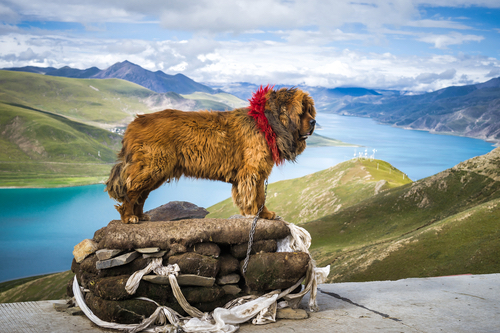
In Tibet, one might see a Tibetan Mastiff wearing a Kekhor, or ske’kor, the latter being a combination of the words “ske” which means neck, and “kor” which means circle, The Kekhor is a traditional collar made from yak hair that’s been dyed red, though some are black, yellow, or mixed colors, and some feature bells. A few ancient types even include Yak caudal vertebras to reinforce them.
More than just a ceremonial accouterment, the Kekhor is multi-purposed and has an ancient history: The great Erdene Zuu temple built by Abtai Sain Khan in 1585 included frescoes showing dogs wearing kekhors. The collar serves to identify a dog as a purebred Tibetan Mastiff, but also helps with visual recognition from a distance (is that a bear or is that my dog?). It makes the dog look larger and imposing to predators, especially when the yak hair flutters in the wind, but should a predator get too close, Tibetan owners believe a Kekhor provides extra protection for the dog’s neck from the attack of a snow leopard or wolf.
Kekhors are quite beautiful, and some people use them as decorative elements in their homes. They are available commercially (we found them here, here, and here), but buyer beware. Fresh out of the bag, a Kekhor has a “fragrant” odor (think yaks in a barnyard) and some people choose to “air” a new Kekhor outside until the smell has been neutralized.
Fans of the breed may want to read a blog we came across expressly written about the breed, Drokpa Tibetan Mastiff.
Image of a Tibetan Mastiff wearing a Kekhor at Yamroke Lake in Tibet by Vlade-Mir
